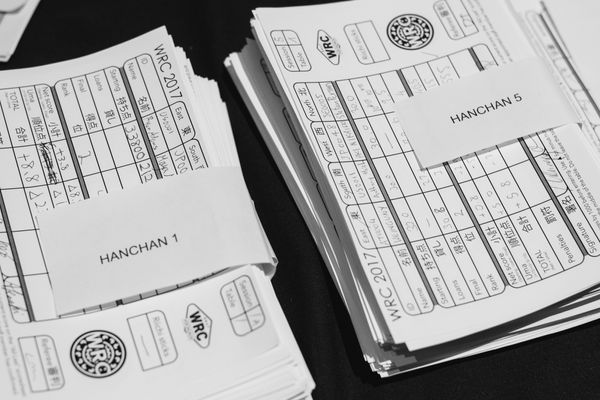Some random thoughts on scoring

Hey, this is UmaiKeiki once again. I think it's cool when people who play mostly internet mahjong take time to learn how to score hands, even though the computer does it all automatically. Here are a few things that I learned during my own quest to figure out the scoring system; I hope they'll be useful to you as well.
First off, here are a few resources you'll want to have at hand:
Guide to scoring
This post won't be a guide to scoring itself as there are already plenty of those. However, you will need one, and despite its age, Wei-hwa Huang's Japanese Mahjong Scoring is still the best English language guide on the internet.http://www.ofb.net/~whuang/ugcs/gp/mahjong/mahjong.html
The best part about this guide is that it includes the Japanese terms plus several common English terms for everything, so you'll be better prepared to understand what other people are talking about in their own guides.
If you're a beginner, you might be interested in printing some kind of reference sheet that you can look at during games. The EMA have a sheet based on their custom rules, which are somewhat different than most common Japanese Mahjong rules. Since their sheet has caused so much confusion for beginners, I can't recommend it. You'll be better off playing against CPU opponents, so you can take your time while playing and study an in-depth rules guide like the one above. Here's a good CPU game:
http://gamedesign.jp/flash/mahjong/mahjong_e.html
Score chart
Once you have figured out how Fu and Han are multiplied to get the final score, you might wonder how people calculate their hand scores so quickly. The answer is that they don't calculate but rather memorize a score chart. You'll definitely want to obtain a good, concise score chart as soon as possible. Here's my favorite chart which I found on the website of Henachoko Mahjong Club.
If you're wondering how to memorize points higher than Mangan, try to think of them as multiples of Mangan. For example,
Haneman = Mangan x 1.5
Baiman = Mangan x 2
Sanbaiman = Mangan x 3
Yakuman = Mangan x 4
Sometimes people refer to double yakuman as "baiyakuman" and triple as "sanbaiyakuman", and so on, to maintain the pattern.
A challenger appears! Check out this coloured chart by CRiX!
Score quizzes
Yeah, shameless plug time!The best way to memorize the yaku is to see them in use, and the best way to learn scoring is to score many hands. Playing live games is a good way to do this, but for those without this luxury, I made some applets that generate random hands for you to practice on. You can find them among the tools on Tenhou documentation site.
The Yaku Quiz is for beginners who are trying to memorize the yaku. It gives you a big checklist and all you have to do is check off what yaku you can see. Don't be intimidated by the size of the list. There are just a lot of yakuman (and character tiles are expanded as well.)
The Score Quiz is mainly for people who play internet mahjong that want to figure out scoring before they go to a real game. This one covers Han, Fu, and payments. For those trying to practice counting Fu, you can enter the exact (unrounded) number if you want.
It uses basically the same rules as Tenhou, but with double Yakuman and two additional yaku: Dai Sha Rin and Open Riichi (because it's awesome.)
Also be warned that it counts Shanpon waits won by Ron as concealed (an kou), which is an oversight and not an actual scoring rule. (Suu an kou shanpon still has to be a tsumo though.)
Terminology
You'll probably notice that most english guides use their own English terms for everything. When everyone makes up their own terms to describe the same thing, it can get pretty creative, but not very helpful. The only constants are the Japanese terms, so you might want to learn as many of those as you can to avoid confusion.Yaku vs. Han confusion
There are a lot of times when people confuse Yaku with Han. Sadly, the first two sites I linked make the same mistake. Here's clarification:Yaku are scoring patterns in the hand. For example, Tanyao is a yaku, and Toitoi is a yaku.
Han are units that measure the value of the yaku. For example, Tanyao is worth 1 han, and Toitoi is worth 2 Han.
Pretty simple. Toitoi is 2 han, but it's not 2 yaku.
Kui-sagari
Kui-sagari is the property of some yaku that makes them worth 1 less Han when open. For example, Hon Itsu is normally worth 3 Han but is reduced to 2 Han if you have called any tiles. What I find funny, though, is that a lot of English guides present this the other way around: they'll tell you that Hon Itsu is normally worth 2 Han, but gets +1 when closed. It's as if they know that most games with westerners are going to be pon palace!Jokes aside, the numbers are the same so it doesn't matter how it's presented. However it may help your play style if you think of there being a penalty for an occasional open hand rather than a bonus for an occasional closed hand.
Scoring Chii toi tsu
The "seven pairs" hand might be intimidating to beginners because it uses 25 fu instead of a round 10, some charts do not include a row for 25 fu, and some rulesets score it as 1 han, 50 fu.Fear not! We can make it really simple. Just score your chii toi tsu as if it were worth 1 han, 50 fu and you'll get the exact same results (below mangan)!
As proof, here's a score chart comparing 25 vs. 50 fu payments.
| 1 han | 2 han | 3 han | 4 han | 5 han | |
| 25 | N/A | 1600 | 3200 | 6400 | Mangan |
| 50 | 1600 | 3200 | 6400 | Mangan |
Associative property
The reason that 25 fu, 2 han is equal to 50 fu, 1 han is because:25 * (2 * 2 * 2 * 2) = (25 * 2) * (2 * 2 * 2).
You might have noticed that this isn't limited to Chii toi tsu. In fact we can generalize this into two theories:
(1) Doubling the Fu is equivalent to increasing Han by 1.
(2) Halving the Fu is equivalent to decreasing Han by 1.
Here's how to put this into practice. Let's suppose you have memorized the hand values for 40 Fu at all Han. Without a chart, how can you give the value of 80 Fu at 2 Han?
Start at 40 Fu, 2 Han. Since you can't double the Fu, instead increase Han by 1. This gives 40 Fu, 3 Han which is equal to 80 Fu, 2 Han!
Now how can you get the value of 20 Fu, 2 Han? Again, start at 40 Fu, 2 Han. This time, subtract Han by 1. This gives 40 Fu, 1 Han which is equal to 20 Fu, 2 Han!
If you're confused, take a look at this table.
| 1 han | 2 han | 3 han | 4 han | 5 han | |
| 20 | N/A | 1300 | 2600 | 5200 | Mangan |
| 40 | 1300 | 2600 | 5200 | Mangan | |
| 80 | 2600 | 5200 | Mangan |
The smallest possible score
Many charts won't have a value for 20 Fu, 1 Han. That's because you just can't make a hand that cheap.What happens if you make an open Tanyao using Shuntsu only, a Ryanmen wait, and win by Ron? Should be worth 20 Fu, 1 Han right?
Actually, such a hand is called "kui-pinfu" or open pinfu, and will be scored as 30 Fu, 1 Han. Since a kui-pinfu is the only way to get 20 Fu, 1 Han, we can thus say the lowest possible score for a hand is 1000 points.
Unrelated to kui-pinfu is the 30 Fu, 1 Han hand won by Tsumo. Such a hand is called "gomi", because of the payments (500, 300 = 5, 3 = go, mi), and because "gomi" means "trash".
The highest possible score
What's the highest possible score you can get? While this probably won't have any real life application, ever, here's a cool example that I once found on Japanese Wikipedia. When I went back to find it again, I discovered that it had been deleted due to being "original research". Pfft! It was amusing enough to me, so here I have reproduced it:Round wind: East
Seat Wind: East
![]()
![]()
![]()
![]()
![]()
![]()
![]()
![]()
![]()
![]()
![]()
![]()
![]()
![]()
![]()
![]()
![]()
Ron: ![]()
Dora indicators: ![]()
![]()
![]()
![]()
![]()
Uradora indicators: ![]()
![]()
![]()
![]()
![]()
Not shown: All 8 flower tiles extracted from the hand.
Here's how it works. This is using a rule known as "aotenjuu" (one reading of 青天井). It means "no limits" and eliminates Mangan, Yakuman, etc. So for example if you have a 30 Fu, 5 Han hand, it's worth 15400 points instead of being capped at 8000. Yakuman are worth 13 Han and can be combined with normal yaku. In addition, Wareme is also in effect, meaning that the payment for this hand is doubled.
So here's what the above hand gets:
Dai san gen: +13
Tsuu ii sou: +13
Suu an kou tanki wait: +26
Suu kan tsu: +13
Renhou: +13
"Flower Yakuman": +13
Open riichi, win by Ron: +13
8 Ren Chan: +13
Riichi + Double + Open: +3
Ippatsu: +1
Toitoi: +2
Yakuhai: +5
Dora: +24
Flowers: +8
Total: 160 fu, 160 han.
(160 x 6 x 2^162) x 2 = 11,224,332,574,701,334,411,804,299,515,261,053,590,957,561,930,055,800 points.
Fun, eh? If you ever get hit by this, you'll have a debt that can only be paid off by playing restricted Rock Paper Scissors on a cruise ship...




